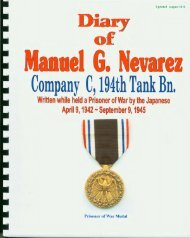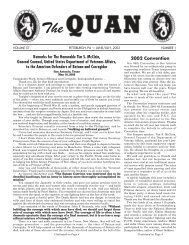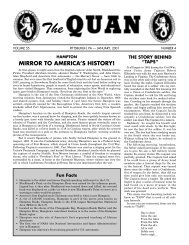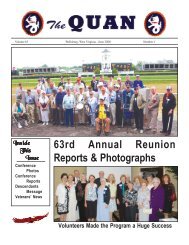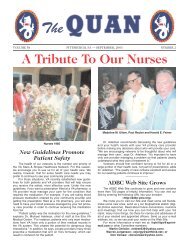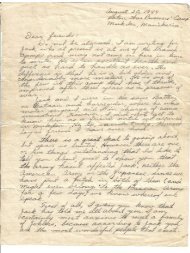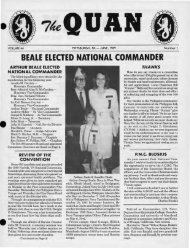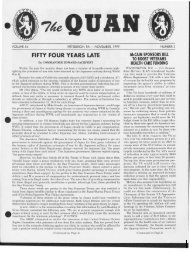18f-6~ ·J~.J.~"'l - Philippine Defenders Main
18f-6~ ·J~.J.~"'l - Philippine Defenders Main
18f-6~ ·J~.J.~"'l - Philippine Defenders Main
You also want an ePaper? Increase the reach of your titles
YUMPU automatically turns print PDFs into web optimized ePapers that Google loves.
724th AVIATION ORDNANCE COMPANY (Continued).<br />
Death March.<br />
On 9 April 1942, the day MAJOR GENERAL EDWARD P KING, JR, surrendered Bataan,<br />
COL HURST ordered the remaining members of the 724th Aviation Ordnance Com-<br />
pany, four (4) officers and forty-six (46) enlisted men to Corregidor; they<br />
were transported by tug boats and barges, arriving at approximately 4 AM.<br />
Upon arrival they were told by the Commanding Officers, 4th US Marines, that<br />
as they were seasoned troops coming in from Bataan they were assigned to<br />
the Marines to help defend the beaches. Ten (10) enlisted men and two (2)<br />
officers were killed. PVT HAROLD JERSHEFSKI lost a leg there, and many<br />
others were wounded, with some dying later.<br />
CAPTAIN CHARLES JAMES, LT CHARLES GAGE, T/SGT RUDOLPH MALCHER, 1st/SGT<br />
WILLIAM BEUS and a Marine major, were in a foxhole; Beus left it just min<br />
utes before the Japs got a direct hit on it and killed the three (3) officers<br />
and one (1) T/SGT instantly.<br />
On 6 May 1942 LT GENERAL JONATHAN M WAINWRIGHT surrendered Corregidor. About<br />
two weeks later the Japanese took the prisoners-of-war to Manila Port Area<br />
by barge and cargo steamer. Upon arrival the wounded were put on trucks<br />
and sent to Bilibid Prison where most of them remained until liberated by a<br />
unit of the 37th Infantry Division in February 1945. Others from Corregidor<br />
were marched approximately four to five miles to the train station and sent to<br />
Cabanatuan Prison Camp. A clarification is necessary here: the ones left on<br />
Bataan, that were not killed, made the Bataan death March; those captured on<br />
CORREGIDOR DID NOT MAKE THE BATAAN DEATH MARCH AS IT WAS ALREADY PAST HISTORY<br />
WHEN THEY WERE CAPTURED. Most of those that died in Cabanatuan were those<br />
who suffered effects of the horrible Bataan Death March. On 1 June 1942<br />
the Japs moved the Bataan Death March survivors from the hell-hole O'Donnell<br />
Prison Camp to Cabanatuan as a Japanese officer said too many were dying<br />
there. The POWs from Corregidor that were in Cabanatuan, were in shock when<br />
they saw the condition of the Bataan Death March survivors, who were suffering<br />
not only from maltreatment by the Japanese, but bordered on starvation and<br />
were disease ridden from lack of food, water and medicine.<br />
Americans died at Camp O'Donnell.<br />
At least 1,500<br />
At Cabanatuan Prison Camp the Japanese put the prisoners-of-war in "BLOOD<br />
BROTHER" groups of then (10); if one (1) escaped the other nine (9) would be<br />
executed. Nine were shot and one was beheaded and witnessed by the entire<br />
camp. Norman Martin just missed being shot by two minutes. The Japs had a<br />
surprise roll call in the middle of the night and he had been outside the<br />
3.
724th AVIATION ORDNANCE COMPANY (Continued).<br />
All information in this write-up has been verified by WO NORMAN MARTIN,<br />
CH M/SGT WILLIAM BEUS, M/SGT WILLIS ELLIS, SR M/SGT EDWIN RAYNOR, HAROLD<br />
JERSHEFSKI, ALBERT MOSS, and other living survivors. I wish to thank, and<br />
acknowledge MAJ WALTER C REGEHR, USAF RETIRED, a former member of HQ & HQ<br />
SQDN, 5th Air Base Group, for his contributions, and for furnishing some of<br />
the missing links on page 1, paragraphs three through seven. He currently<br />
resides at 5137 Elbert Way, Sacramento, CA 95842, AC 916-332-3671.<br />
Captain, US Army (Retired)<br />
5471 Tara Drive<br />
Clayton, CA 94517-1065<br />
PH: (415) 672-4338<br />
SYMBOLS:<br />
+<br />
++<br />
ENCLOSURES:<br />
died during the war<br />
died in US after liberation<br />
still living<br />
Original Company strength<br />
Item for publication: Pages 1,2,3,4, and 5<br />
Original Roster dated 15 November 1941<br />
Current Roster of Survivors dated 24 April 1990<br />
Copy Special Orders No. 24, dated 25 January 1942<br />
Blood Brothers Group, Cabanatuan Prison Camp, dated 18 August 1942<br />
NOT ENCLOSED, AVAILABLE ONLY BY REQUEST:<br />
31<br />
1 1<br />
22<br />
64<br />
"Accounting of the Hell Ship, Oroyko Maru, and subsequent events before<br />
arriving in Japan". Written by General Harold K. Johnson, US Army (Ret.),<br />
who was a survivor. General Johnson, former Chief of Staff, died in<br />
September 1983.<br />
"History of Cabanatuan Prison Camp 1942 - 1945" written by MAJ GEN Chester<br />
L. Johnson, US Army (Ret.), General Chairman, Cabanatuan Memorial<br />
Committee, in June 1984.<br />
5 •
Veterans still can't escape Bataan'<br />
By SKIP HOLLANDSWORTH<br />
Staff Writer<br />
It has been 41 years since Bataan.<br />
Retired U. S. Army Lt. Col. Dick<br />
Jones says he .has "forgived and forgotten."<br />
He drives a Japanese-built<br />
car. " You try to look on it now in<br />
retrospect, without the hardship and<br />
despair," Jones said, "and hope it<br />
teaches you something about the thrill<br />
of just being alive."<br />
But for most of the others who<br />
were forced to walk in the infamous<br />
Bataan Death March, the sense of bitterness<br />
remains.<br />
. The men who were in the march<br />
gathered last week in Dallas to again<br />
try to come to terms with one of the<br />
most searing, inhuman experiences of<br />
World War II. About 37.000 U. S. and<br />
Filipino soldiers were captured in<br />
1942 by the Japanese on the Bataan<br />
peninsula and Corregidor island in the<br />
<strong>Philippine</strong>s and forced to march 70<br />
miles to the sea. Thousands died dur-<br />
ing the nine-day march . .<br />
The soldiers had no food or water<br />
and were shot by their Japanese captors<br />
if they stopped to rest. At the sea,<br />
they were loaded onto crowded ships<br />
for the trip to prison camps in Japan,<br />
where for three years they were fed a<br />
couple of handfuls of rice a day.<br />
\ "I'm not sure how to explain why<br />
we get together," said Jones, 73, who<br />
came from- Claremont, Calif., to the '.'<br />
Dallas reunion. Retired Lt. Col. Har<br />
See REUNION on Page S<br />
P hoto at left shows<br />
Capt. William G .<br />
Adair, second from<br />
left; Capt. Wayne<br />
Hightower, second<br />
from right; and Capt.<br />
Kermit Lay, right, in<br />
a Japanese prisonerof-war<br />
camp during<br />
World War II. At<br />
right, they occupy<br />
the same posi tions<br />
during their Dallas<br />
reunion.



